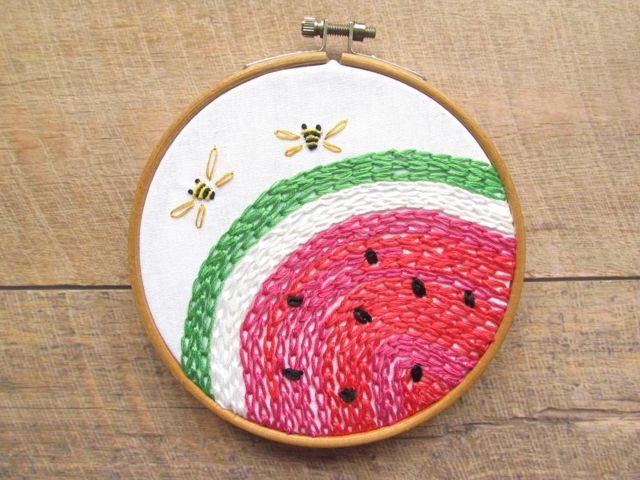Winter is firmly entrenched in the Glass House Mountains and brings cold fog and rain or sunny days with freezing nights. Even so, Australia is mainly populated along the coasts, and it's beach weather somewhere so summer is never far from the mind.
Today's bone-chilling pea-souper fog has led me to warm myself up by putting together a tutorial for a summery watermelon embroidery. It doesn't get much sunnier at heart than watermelon and a couple of bright and buzzing bees.
The watermelon is made using chain stitch and the seeds are lazy daisies which are really just individual links of the chain. The little bees are made using bullion knots, french knots, and lazy daisy stitch. We learned how to make chain stitch in Embroidery School's Lesson Four and lazy daisy stitches and french knots stitches in Lesson Six. For this tutorial, I've included how to make bullion knots so you have all the skills you need.
Materials needed:
5" embroidery hoop
6" or 7" embroidery hoop
white cotton embroidery fabric
pencil
colored pencils (optional)
needles
scissors
DMC stranded cotton embroidery floss:
310 black (seeds: 6 strands/ bee: 3 strands)
3058 pink (6 strands)
3831 salmon (6 strands)
732 green (6 strands)
726 yellow (3 strands)
972 gold (2 strands)
Blanc (6 strands)
NOTE: The work is done using a larger hoop and then the finished embroidery is framed in the smaller hoop.
My watermelon uses two colors for the fruit because I realized I was going to run out of the pink. You can use one or both colors or another pink of your choice. I rather like the two colors together.
WATERMELON AND BEES EMBROIDERY:
To make the watermelon:
1) Prepare the fabric by tracing the inside of the 5" hoop on the wrong side of the fabric. Using sewing thread or a single strand of any embroidery floss, baste a line of running stitches along the traced line. This is just to give you the perimeter of the circle without having to mark the right side of the fabric.
2) Using the inner ring of the 5" hoop, lightly trace the outer edge of the ring to make the area for the watermelon. Just leave enough room for the bees outside the area designated for the watermelon.
3) I used colored pencils (Staedtler children's colored pencils) to darken the rind and fruit areas of the watermelon. This is optional. At first, I made it too light and then darkened it up. I think I could have made it much darker. Experiment! Or do without.
4) Start at the top edge of the juicy pink fruit and chain around the shape of the watermelon in an arc. At the end of the first arc, finish off the stitch and then start a new row going in the opposite direction. Continue working chains until the fruit is filled.
5) Stitch 2 or 3 rows of Blanc chain arcs above the pink fruit.
6) Stitch 2 or 3 rows of green rind above the white.
7) Make a few randomly placed black lazy daisy seeds adding a single stitch in the center to loosely fill the stitch.
Before we make the bees, we have to learn to make the Bullion Knot.
New stitch:
Bullion Knot
Bring the needle to the front of the fabric at A. Insert the needle at B and bring the needle halfway out at A. The distance from A to B is the length of the stitch. Be careful not to split the thread.
Wrap the thread around the tip of the needle five or six times and pack the wraps down evenly around the needle.
Hold the wraps in place around the needle and pull the needle through the fabric and the wraps.
Pull the thread towards B and push the wraps into place. This should tighten the stitch onto the fabric.
Insert the needle at B and bring the thread to the back of the fabric.
To make the bees:
Each bee is made of 6 bullion knots (small to large), 2 french knots, and lazy daisy wings.
1) Lay down 3 black bullion knots leaving some space between. Wrap the smallest 3 times, the middle knot gets 5 wraps, and the largest gets 7 wraps.
2) Then use the yellow to make the alternating bullion knots of 4, 6, and 8 wraps.
3) Make two french knot antennae, wrapping just once to make a small knot. Add lazy daisy wings, four for each bee.
Pull the basting thread out and mount into a 5" hoop for display or giving.
Bonus lesson!
How to change thread during chain stitch
In Lesson Four of Embroidery School, I showed how to change thread while working blanket stitch. Changing threads during chain stitch is very similar. You might need to change threads to change color or because your have run out of thread.
The keep your chain stitch continuous while changing threads, bring the thread to the back of the fabric, leaving the loop extra large. Leave the tail of the thread at the back side of the fabric.
Thread the needle with the new strand and bring it out the front of the fabric where the end of this chain will be.
Continue to make the next chain stitch, tightening the large loop by pulling gently on the tail. Knot the leftover tail or weave in the tail if you are using the no-knot method.
I feel warmer already! A summer design for a wintery day down under. And if you're in the middle of your summer, enjoy this juicy treat!





















No comments:
Post a Comment